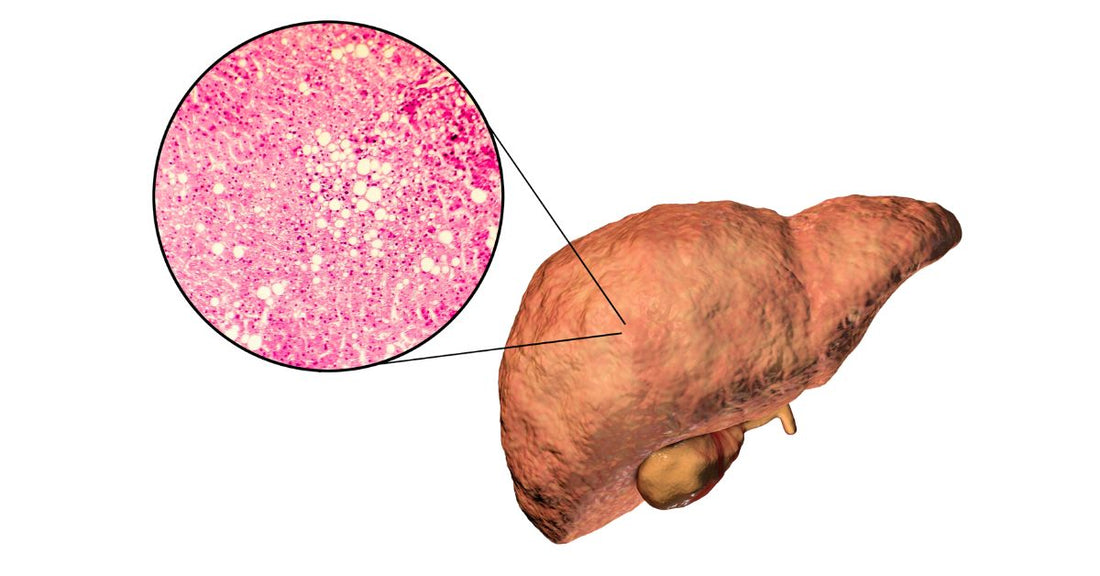
Understanding Fatty Liver Disease: Causes, Symptoms, and Treatment
Share
What Is Fatty Liver Disease?

Fatty liver disease, or hepatic steatosis, occurs when excess fat accumulates in liver cells. It is categorized into two main types:
- Alcoholic Fatty Liver Disease (AFLD): Caused by excessive alcohol consumption.
- Non-Alcoholic Fatty Liver Disease (NAFLD): Associated with metabolic risk factors such as obesity, type 2 diabetes, and high cholesterol.
NAFLD is now referred to as Metabolic Dysfunction-Associated Steatotic Liver Disease (MASLD) to better reflect its metabolic origins.
Symptoms of Fatty Liver Disease

In the early stages, fatty liver disease often presents no symptoms. As the condition progresses, individuals may experience:
- Fatigue
- Discomfort or pain in the upper right abdomen
- Unexplained weight loss
- Jaundice (yellowing of the skin and eyes)
- Swelling in the abdomen or legs
It's important to consult a healthcare provider if any of these symptoms occur.
Causes and Risk Factors

Several factors contribute to the development of fatty liver disease:
- Obesity: Particularly abdominal fat increases liver fat accumulation.
- Type 2 Diabetes: Insulin resistance is a significant risk factor.
- High Cholesterol and Triglycerides: Elevated levels can lead to fat buildup in the liver.
- Poor Diet: Diets high in saturated fats, refined sugars, and processed foods.
- Lack of Physical Activity: Sedentary lifestyle contributes to weight gain and fat accumulation.
Genetic factors and certain medications can also increase risk.
Prevention Strategies

Preventing fatty liver disease involves adopting healthy lifestyle habits:
- Maintain a Healthy Weight: Aim for a balanced weight through diet and exercise.
- Eat a Balanced Diet: Focus on fruits, vegetables, whole grains, lean proteins, and healthy fats.
- Limit Alcohol Consumption: Excessive alcohol intake can exacerbate liver damage.
- Regular Physical Activity: Engage in at least 150 minutes of moderate-intensity exercise per week.
- Avoid Smoking: Smoking accelerates liver damage and increases the risk of complications.
Implementing these changes can significantly reduce the risk of developing fatty liver disease.
Treatment Options

Currently, there are no specific medications approved for fatty liver disease. Treatment focuses on:
- Weight Loss: A gradual weight loss of 3% to 5% can improve liver health; 10% or more can reverse liver damage :contentReference[oaicite:5]{index=5}.
- Dietary Changes: Adopting a Mediterranean diet rich in fruits, vegetables, and healthy fats.
- Physical Activity: Regular exercise helps reduce liver fat and inflammation.
- Management of Underlying Conditions: Controlling diabetes, high cholesterol, and hypertension.
In severe cases, bariatric surgery may be considered for weight reduction.
Conclusion
Fatty liver disease is a serious condition that can lead to liver damage if left untreated. Early detection and lifestyle modifications are crucial in managing and preventing the progression of the disease. Regular check-ups and a commitment to a healthy lifestyle can significantly improve liver health and overall well-being.
👉 Discover and purchase Liver Support + Capsules

The information provided in this article is for general informational purposes only. It is not intended as a substitute for professional medical advice, diagnosis, or treatment. Always seek the advice of your physician or another qualified healthcare provider with any questions you may have regarding a medical condition. Never disregard professional medical advice or delay in seeking it because of something you have read on this website. If you think you may have a medical emergency, call your doctor or emergency services immediately.
